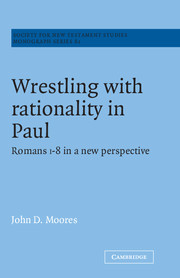Book contents
- Frontmatter
- Contents
- Acknowledgements
- List of abbreviations
- Introduction: The layout of this study and the approach behind it
- 1 Enthymematic semiosis in Paul
- 2 Varieties of enthymematic effect in Romans 1–4
- 3 Ways in which enthymemes arise in Romans 5–7
- 4 How enthymematic argument stands in Romans 8
- 5 Knowing what tune Paul is playing
- Conclusions reached their scope assessed
- Notes
- Bibliography
- Index of names
- Index of technical terms
5 - Knowing what tune Paul is playing
Published online by Cambridge University Press: 08 October 2009
- Frontmatter
- Contents
- Acknowledgements
- List of abbreviations
- Introduction: The layout of this study and the approach behind it
- 1 Enthymematic semiosis in Paul
- 2 Varieties of enthymematic effect in Romans 1–4
- 3 Ways in which enthymemes arise in Romans 5–7
- 4 How enthymematic argument stands in Romans 8
- 5 Knowing what tune Paul is playing
- Conclusions reached their scope assessed
- Notes
- Bibliography
- Index of names
- Index of technical terms
Summary
Coding and clarity in Guiraud and Prieto. Paul's own view of communication, and the problem it highlights.
In my opening discussion I took Eco as my mentor in semiological theory and relegated any references to other theoreticians to the notes. Consideration of the theories of other semiologists and of the relation of semiological theory to other kindred disciplines such as communication theory and linguistics (as well as psychology, anthropology and aesthetics) occupies a great deal of space in his writings. It is possible, in consequence, to trace back to earlier research the vast majority of his basic ideas, though their relation to it is almost always complex, and it is rare for him to adopt an idea without in some way remodelling or redeploying it. In due course this chapter will lead me around to Eco again, but in the earlier part of it I shall bring into play some theories which (though reflected in his) display a particular relevance to Paul in their original form, or at some stage in their development prior to their assimilation by Eco, like the analytical refinements of the coding factor in semiosis for which I turn to the two linguists Pierre Guiraud and Luis Prieto. This is my first step in that ‘subtler appreciation of signification’ which I have said we need to pursue (supra, p. 131).
- Type
- Chapter
- Information
- Wrestling with Rationality in PaulRomans 1-8 in a New Perspective, pp. 132 - 158Publisher: Cambridge University PressPrint publication year: 1995



